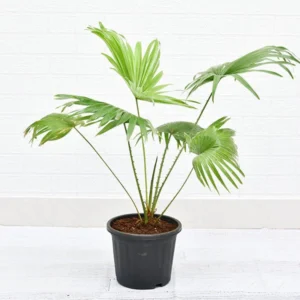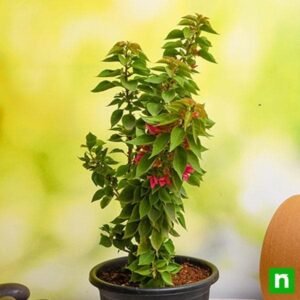Description
Nandivardhana (Variegated) Plant – A 1000-word Description
The Nandivardhana (Variegated) plant, known for its ornamental charm and cultural importance, is a popular choice among garden enthusiasts, landscapers, and spiritual plant collectors. Commonly referred to by various names in different regions, such as Tabernaemontana divaricata variegata, Pinwheel Flower, or Crape Jasmine, this plant stands out not only for its aesthetic appeal but also for its resilience and versatile applications in both indoor and outdoor settings.
Botanical Identity and Classification
- Botanical Name: Tabernaemontana divaricata variegata
- Common Names: Crape Jasmine, Pinwheel Flower, East Indian Rosebay
- Family: Apocynaceae
- Native Range: Tropical Asia, particularly India and Southeast Asia
The Nandivardhana plant belongs to the Apocynaceae family, a group known for its flowering shrubs and trees. The variegated version is a cultivated variety that features uniquely patterned leaves, often green with creamy white or yellow margins, making it especially attractive in decorative landscapes.
Physical Description
The variegated Nandivardhana is a medium-sized evergreen shrub or small tree that grows between 4 to 8 feet in height, though it can be pruned and maintained at a smaller size for ornamental use.
- Leaves: The leaves are elliptical, glossy, and leathery in texture. In the variegated variety, the foliage displays striking cream or white variegation against deep green backgrounds. This variegation offers visual contrast and makes the plant an excellent choice for decorative purposes.
- Flowers: The plant produces beautiful, white, pinwheel-like flowers, typically around 2–3 cm in diameter. These blooms are five-petaled and mildly fragrant, often appearing in small clusters at the tips of branches. The white flowers stand out vividly against the variegated leaves, enhancing the overall aesthetic.
- Growth Habit: It has a dense, bushy habit with multiple branching stems. The plant maintains a compact shape, making it suitable for both ground planting and container gardening.
Cultural and Spiritual Significance
In India and other parts of Asia, Nandivardhana holds religious and cultural significance. The plant is often grown in temple gardens and home courtyards due to its association with purity and divinity.
- The name “Nandivardhana” is derived from Sanskrit, where “Nandi” refers to the sacred bull of Lord Shiva and “vardhana” means to increase or flourish. It is believed that growing this plant invites blessings, peace, and prosperity into the home.
- The white flowers are sometimes used in religious offerings and rituals, symbolizing purity and spiritual growth.
Growing Conditions and Requirements
Nandivardhana (Variegated) is an adaptable and low-maintenance plant, making it ideal for both novice and experienced gardeners.
- Light: Prefers full sunlight to partial shade. Too much shade can reduce variegation intensity, while bright indirect light enhances the foliage contrast.
- Soil: Grows best in well-draining soil that is rich in organic matter. Slightly acidic to neutral soil pH (6.0–7.5) is ideal.
- Watering: Requires moderate watering. The soil should be kept moist but not waterlogged. Overwatering may lead to root rot, especially in poorly draining containers.
- Temperature: Thrives in tropical and subtropical climates. The plant prefers temperatures between 20°C to 35°C (68°F to 95°F) and does not tolerate frost well.
- Humidity: Favors high humidity environments but can adapt to moderately dry conditions with proper care.
- Fertilization: Use a balanced, slow-release fertilizer every few months during the growing season to encourage flowering and maintain vibrant foliage.
- Pruning: Regular pruning helps maintain shape and encourages bushier growth. Dead or leggy stems should be trimmed to stimulate fresh branching.
Propagation
Propagation of the Nandivardhana variegated plant can be done through:
- Stem Cuttings: The most common method. Semi-hardwood cuttings taken in the growing season (spring or early summer) root easily in moist soil or water.
- Air Layering: Suitable for mature branches, producing faster and more reliable rooting.
- Seed Propagation: Less common due to slow growth and low germination rates, especially for variegated varieties.
Pests and Diseases
The Nandivardhana plant is relatively pest-resistant, though it can occasionally suffer from:
- Mealybugs and aphids, which can be controlled with neem oil or insecticidal soap.
- Scale insects, particularly in humid conditions.
- Fungal leaf spots and powdery mildew, especially if airflow around the plant is restricted.
Good hygiene, proper watering, and occasional application of organic pesticides can help keep these issues at bay.
Landscaping and Ornamental Use
Due to its stunning appearance, the variegated Nandivardhana is widely used in:
- Home gardens, particularly in decorative borders and flower beds.
- Containers and pots, both indoors and outdoors.
- Temple and spiritual gardens, thanks to its association with religious rituals.
- Tropical and subtropical landscapes, for contrast and color balance.
- Hedges or screens, due to its bushy nature and dense foliage.
The combination of variegated leaves and bright white flowers makes it an excellent focal point in any garden setup.
Indoor Use and Air Quality
Though typically grown outdoors, the Nandivardhana plant can also be kept indoors near a bright window. It adds a touch of elegance and has the added benefit of purifying the air. Its glossy leaves help trap dust, and like many plants, it absorbs carbon dioxide and releases oxygen, contributing to better indoor air quality.
Symbolism and Feng Shui
In Feng Shui, plants with variegated leaves and white flowers are believed to bring balance and calm to the home. Nandivardhana is often placed in the northeast corner of the house to promote positive energy flow, wisdom, and harmony.
Conclusion
The Nandivardhana (Variegated) plant is a remarkable combination of beauty, resilience, and cultural heritage. Its uniquely patterned foliage, fragrant flowers, and minimal maintenance requirements make it a treasured addition to gardens, balconies, and sacred spaces. Whether used as a decorative element or grown for its symbolic significance, this plant brings both visual pleasure and spiritual enrichment.
With the right care, the Nandivardhana variegated plant can thrive for many years, offering a serene and lush presence wherever it is planted.





 Plant Pack For Healthy Home-Office
Plant Pack For Healthy Home-Office 

Reviews
There are no reviews yet.